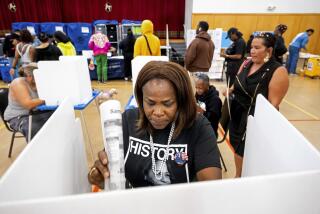A popular vote president
- Share via
What do presidents Benjamin Harrison, Rutherford B. Hayes and George W. Bush have in common? All were elected president even though their opponents received more votes. Each of those campaigns was thus a spectacular controversy, and after more than a century of such sporadic but unsettling political results, at last there is a real chance for change.
Bush’s victory in 2000 over Al Gore is obviously the freshest and rawest of these electoral aberrations, which grow out of the nation’s unusual presidential selection process. The founders believed in a mediated democracy and created a republic that would insulate elections from the rabble. Wary of investing the people (excluding women and slaves, of course) with too much power, skittish about the potential influence of political parties and debating in an era when the people of one state knew little about the leaders of others, the drafters of the Constitution settled on a two-tiered system of selecting presidents: States chose electors, and those electors in turn selected a president. As specified by Article 2, Section 1 of the Constitution, each state was allowed to appoint electors equal to the number of congressional representatives it possessed. Actual voters had no role.
How the states chose those electors was left to them. Initially, that was done by legislatures, but as American notions of egalitarianism overcame some of the founders’ reservations about trusting voters — and as communications united the states in ways unimaginable to those who wrote the original documents — the choosing of electors moved to the people. Today’s presidential races still are two-tiered, but voters at least participate at the front end. In every state but two, where electors are allocated by congressional district, voters cast ballots for president and the candidate who wins the most votes wins all of the state’s electors.
The trouble with winner-take-all rules can be seen in the results of two modern elections: The 2000 race, of course, saw the loser of the popular vote become president after winning a protracted squeaker in Florida. Four years later, Bush handily defeated John Kerry by 3 million votes, but had a mere 60,000 more Ohioans voted instead for Kerry, the nation would have experienced a mirror-image of 2000: Kerry would have won the election while losing the popular vote. That close call was possible, of course, because winning a state by one vote matters just as much as winning it by millions. It is a reminder that the current rules do not unequivocally favor either party, nor would changing them benefit one over the other.
What both sides recognize is the effect that winner-take-all rules have on campaigns. Candidates who are far ahead or far behind in a state have no reason to waste time on them. Barack Obama, for instance, was a prohibitive favorite to win California in 2008, so he spent neither time nor money here after the primaries. Similarly, John McCain knew he would lose this state, so he concentrated his efforts elsewhere. The result was typical: a national political campaign waged in a handful of battleground states such as Ohio and Florida.
There’s an easy way and a hard way to address these problems. One would be to abolish the use of electors — known as the electoral college, though that phrase never appears in the Constitution. That’s the hard way. It requires a constitutional amendment, which would have to be approved by two-thirds of Congress and ratified by three-quarters of the states. But there’s another approach: If enough states agree to vote their electors for whichever candidate wins the national popular vote, then the popular contest can effectively be the binding one. In other words, if states that together control a majority of electoral votes all cast them for the winner of the popular vote, that guarantees that the election goes to the person with the most votes.
So far, eight states with a combined 77 electoral votes — 29% of the 270 needed to win — have passed laws to do just that. A bill with bipartisan support in the Legislature would add California, by far the biggest such prize with 55 electoral votes, to that roll. And it would go into effect only when enough states join to ensure the strategy’s success, so there is no danger of any state tossing away its votes without them going to the popular vote winner. Twice before, similar bills have passed the Legislature, but Gov. Arnold Schwarzenegger vetoed them.
Proponents of the bill make an economic argument for it as well. As President Obama’s recent trip to Los Angeles highlighted, this state provides much of the money that pays for modern politics. But because California is so solidly Democratic that its electoral votes are a foregone conclusion, neither party spends much money to get votes here. A national popular vote might infuse the state economy with some of the benefits of the national election: advertising, campaign staffs and offices, and the like.
That’s all fine, but what should guide this debate is a recognition that our evolving electoral system has embraced increasingly democratic notions of how we pick our leaders. This bill represents the natural next step in that evolution, and would finally allow Americans to rest assured that the next president of the United States will be the candidate preferred by voters. The Legislature should pass the bill, and Gov. Jerry Brown should sign it.
More to Read
A cure for the common opinion
Get thought-provoking perspectives with our weekly newsletter.
You may occasionally receive promotional content from the Los Angeles Times.






